Maiden Erlegh Lake in Spring and early Summer
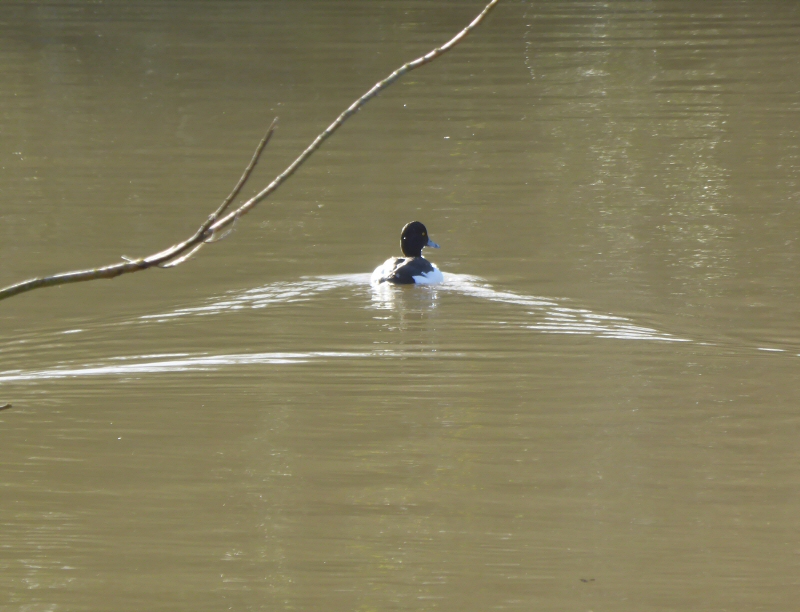 After a mild winter - which saw visiting birds such as a tufted duck and a rather rarer egret passing through - March ushered in Spring and its promise of new life. By mid month there was definitely a sense of seasonal vitality, with ducks chasing and pairing, coots fighting, last year's grown-up cygnet separating from its parents, grebes arriving from their winter sojourn. I thought it might be interesting to trace the family fortunes of some of the more prominent birds on the lake. After a mild winter - which saw visiting birds such as a tufted duck and a rather rarer egret passing through - March ushered in Spring and its promise of new life. By mid month there was definitely a sense of seasonal vitality, with ducks chasing and pairing, coots fighting, last year's grown-up cygnet separating from its parents, grebes arriving from their winter sojourn. I thought it might be interesting to trace the family fortunes of some of the more prominent birds on the lake.
Egyptian Geese
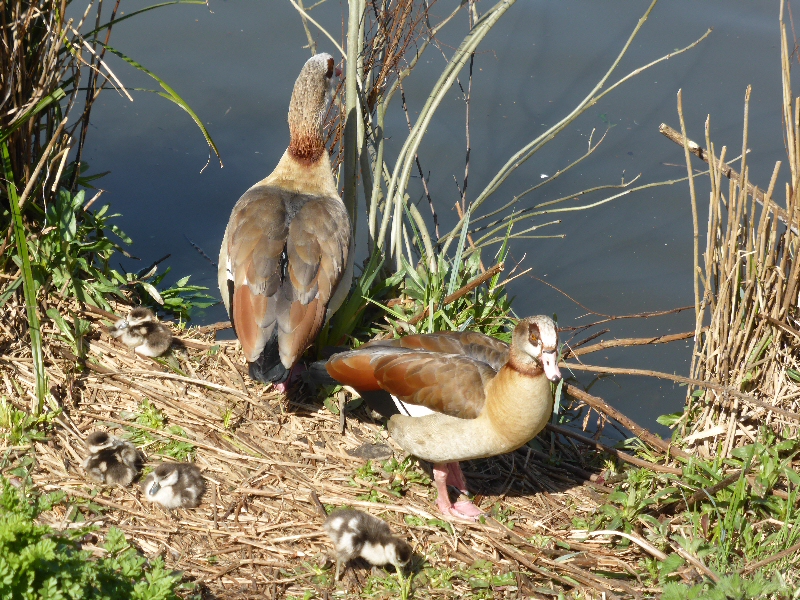 Back after an absence of several years, early sightings in February were for a pair of Egyptian geese, but soon only one was in evidence. The male, assuming that is what it was, remained conspicuous, displaying a partiality for standing on the handrail at the feeding station. On the 4 April, however, the pair was seen together again, leading a flotilla of five goslings out on the water from Big Island to the longer-established silt pocket. Sadly five had become four by 6 April and so remained until 15 May when the family was further depleted. The adults were back on the handrail on 11 May and subsequently, when the two newer silt pockets on Lakeside had found greater favour, on the rail opposite the Duck & the World. Adult feathers were sprouting by mid May as the goslings grew in stature and bulk, but they still tended to cluster together for warmth and security; on 27 May they were in a heap, breathing in measured synchronicity. The closely-knit family started to loosen its bonds in June as from the 5th the goslings could be seen swimming independently of their parents. The male in particular appeared increasingly detached, often standing apart, seemingly on guard, or sometimes, by the end of the month, alone. But as July opened the family was still together, the youngsters in their new flight feathers almost indistinguishable from their parents as they continue to cluster by the silt pockets, or take to perching on the 'Fallen Tree' between Swan Island and the reed bed. Back after an absence of several years, early sightings in February were for a pair of Egyptian geese, but soon only one was in evidence. The male, assuming that is what it was, remained conspicuous, displaying a partiality for standing on the handrail at the feeding station. On the 4 April, however, the pair was seen together again, leading a flotilla of five goslings out on the water from Big Island to the longer-established silt pocket. Sadly five had become four by 6 April and so remained until 15 May when the family was further depleted. The adults were back on the handrail on 11 May and subsequently, when the two newer silt pockets on Lakeside had found greater favour, on the rail opposite the Duck & the World. Adult feathers were sprouting by mid May as the goslings grew in stature and bulk, but they still tended to cluster together for warmth and security; on 27 May they were in a heap, breathing in measured synchronicity. The closely-knit family started to loosen its bonds in June as from the 5th the goslings could be seen swimming independently of their parents. The male in particular appeared increasingly detached, often standing apart, seemingly on guard, or sometimes, by the end of the month, alone. But as July opened the family was still together, the youngsters in their new flight feathers almost indistinguishable from their parents as they continue to cluster by the silt pockets, or take to perching on the 'Fallen Tree' between Swan Island and the reed bed.
Canada Geese
Sadly the same stability can't be said for the resident Canada geese. During the winter their numbers were swollen by visitors, with as many as 46 geese on one occasion in January. Individuals could be seen flying in and being chased off in February, as territorial claims were established. By March, as the green shoots of spring began to appear, geese were grazing on the sward in Lakeside. My interest was aroused when I realised that the goose with the damaged wing (referred to here as 'Broken Wing' or BW) had, after many years' residence, taken up nesting. Her chosen location was rather precarious - on the bank in one of the fishing bays on Lakeside - but there she sat, from 9 April to 4 May, with little protection but for the attentiveness of her mate. The first goslings of the year appeared on 3 May (six of them), and another two by the barley bales on 7 May. Broken Wing was off her nest on 8 May, after sitting for a month, and by the next morning three families could be seen, though numbers were already down: 5 (Lakeside), 1 (Broken Wing), and 1 (Barley Bales). Sadly, after all the anticipation, BW had lost hers by the afternoon! Only three goslings were left on 15 May, just two on 16 May, and all have since disappeared.
Swans
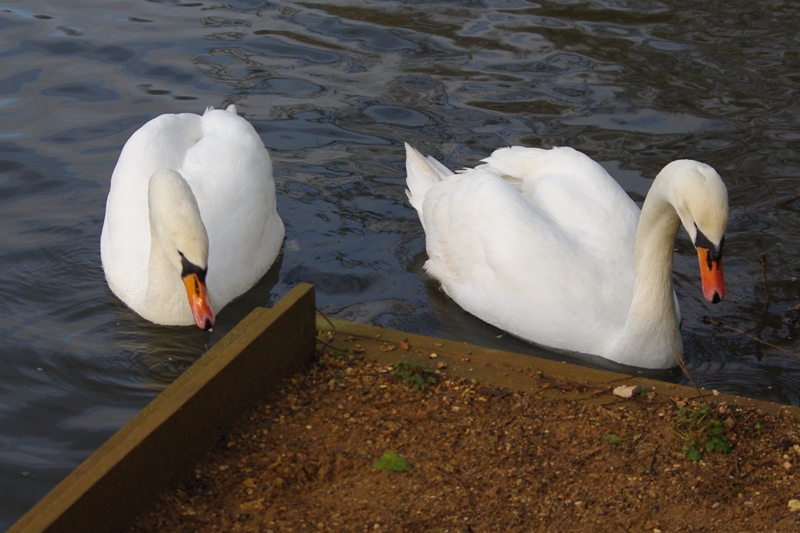 The year opened with the resident pair and just one juvenile remaining from last year's brood, though two young swans appeared on 10 January and there was much fighting and chasing by the adults. The resident family stayed put throughout February and into March, but then the juvenile appeared detached from its parents more frequently, and remained so throughout the following fortnight. It was absent on 23 March and seen no longer. At the end of March the adult male was starting to display his seasonal aggression toward the hapless Canada geese, and the signs were pointing to the prospect of a new family. Sure enough, the courtship display came on 4 April, the pair forming a heart shape with their necks, and the female started to sit on her customary Swan Is nest a day or so later, and remained there until after 13 May. (I believe 36 days is normal.) Four new cygnets appeared on the water on 18 May and the father continued to chase geese with renewed energy. By 11 June the clutch had reduced to three, but the cygnets are now distinctly growing in size. The year opened with the resident pair and just one juvenile remaining from last year's brood, though two young swans appeared on 10 January and there was much fighting and chasing by the adults. The resident family stayed put throughout February and into March, but then the juvenile appeared detached from its parents more frequently, and remained so throughout the following fortnight. It was absent on 23 March and seen no longer. At the end of March the adult male was starting to display his seasonal aggression toward the hapless Canada geese, and the signs were pointing to the prospect of a new family. Sure enough, the courtship display came on 4 April, the pair forming a heart shape with their necks, and the female started to sit on her customary Swan Is nest a day or so later, and remained there until after 13 May. (I believe 36 days is normal.) Four new cygnets appeared on the water on 18 May and the father continued to chase geese with renewed energy. By 11 June the clutch had reduced to three, but the cygnets are now distinctly growing in size.
Cormorant
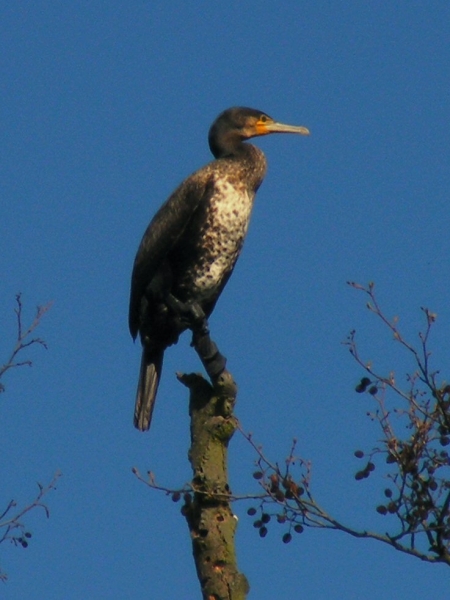 Although cormorants have come to perch in the trees on Big Is for years, usually during the harsher winter weather - and a juvenile has been spotted at least once in the past decade - 2015 has seen a family take up summer residence. Sightings from mid March were usually of one or two, and one occasion three, but the varying composition of adults and juveniles indicates a family of four: two adults and two juveniles. Their main base was on Big Is, where the white stained leaves below betrayed the treetop roost of the adults, with one or two water-level branches for the juveniles. A secondary perch is the Fallen Tree, where sometimes two juveniles can often be found (or one with an adult), spreading out their wings to dry. On occasion one or more would be swimming and diving to catch fish. The juveniles are much paler than the almost black adults, and having established from separate sightings that there were two, I did spy both together on the Fallen Tree in confirmation. Sometimes they would patter across the water with their wings flapping until they laboriously launched into the air for the other end of the lake. When taking off they would often circle Big Is to gain height before flying farther afield, and they appear now to have flown off for the rest of the summer. Although cormorants have come to perch in the trees on Big Is for years, usually during the harsher winter weather - and a juvenile has been spotted at least once in the past decade - 2015 has seen a family take up summer residence. Sightings from mid March were usually of one or two, and one occasion three, but the varying composition of adults and juveniles indicates a family of four: two adults and two juveniles. Their main base was on Big Is, where the white stained leaves below betrayed the treetop roost of the adults, with one or two water-level branches for the juveniles. A secondary perch is the Fallen Tree, where sometimes two juveniles can often be found (or one with an adult), spreading out their wings to dry. On occasion one or more would be swimming and diving to catch fish. The juveniles are much paler than the almost black adults, and having established from separate sightings that there were two, I did spy both together on the Fallen Tree in confirmation. Sometimes they would patter across the water with their wings flapping until they laboriously launched into the air for the other end of the lake. When taking off they would often circle Big Is to gain height before flying farther afield, and they appear now to have flown off for the rest of the summer.
Grebe
I saw a grebe first this year on 28 February, then two on 1 March - one with red crest, one in paler winter plumage - although only single sightings were noted, every few days, throughout March, April and May, and into June. Suspicions that there might be a mate on a nest, further up the bank of Big Island than in previous years, were confirmed on 27 June and 3 July, and sure enough, the grebes seem set to multiply sometime soon.
Heron
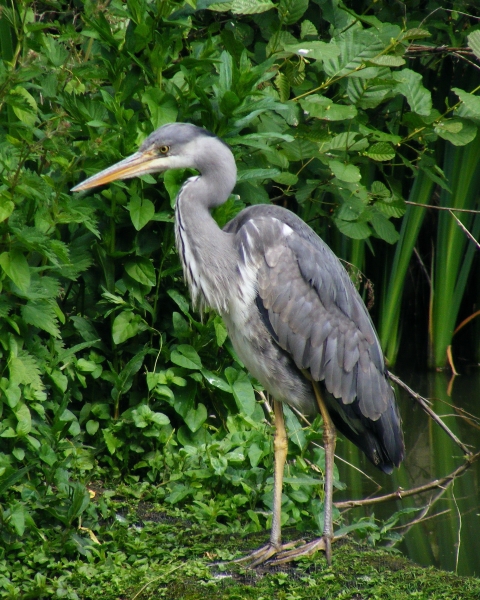 Perhaps not so much a family, the heron is usually seen alone, dominating a number of favoured hunting or resting places: wading in the sediment trap at the Beech Lane inlet, standing on the Duck & the World statue, obscured in the tree in the reed bed, perched on the fence posts along the reed bed, the dead tree opposite, and occasionally prowling on the banks of Big Island. Sometimes a heron will fly low across lake, screeching horribly, and twice in May I have seen one fly through the treetops into, or out of, Old Pond Copse. On 8 May it was on the tree in the reed bed close to the coots' nest, quite possibly having eaten two of the cootlings that disappeared about that time. But though sightings are usually singular, and the heron's black and white head a clear indication of adult plumage, there were two on 7 and 11 July, the second a slender and slighter specimen in grey. If one's a juvenile, there must be another parent somewhere! Perhaps not so much a family, the heron is usually seen alone, dominating a number of favoured hunting or resting places: wading in the sediment trap at the Beech Lane inlet, standing on the Duck & the World statue, obscured in the tree in the reed bed, perched on the fence posts along the reed bed, the dead tree opposite, and occasionally prowling on the banks of Big Island. Sometimes a heron will fly low across lake, screeching horribly, and twice in May I have seen one fly through the treetops into, or out of, Old Pond Copse. On 8 May it was on the tree in the reed bed close to the coots' nest, quite possibly having eaten two of the cootlings that disappeared about that time. But though sightings are usually singular, and the heron's black and white head a clear indication of adult plumage, there were two on 7 and 11 July, the second a slender and slighter specimen in grey. If one's a juvenile, there must be another parent somewhere!
Words by Edwin Trout, photos from the EEG website
|